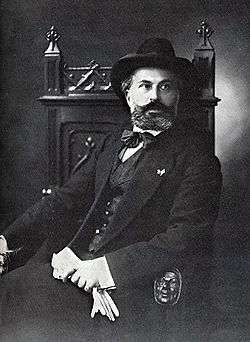Ricciotto Canudo


Ricciotto Canudo (French: [kanydo]; 2 January 1877, Gioia del Colle – 10 November 1923, Paris) was an early Italian film theoretician who lived primarily in France. He saw cinema as "plastic art in motion". He gave cinema the label "the Seventh Art", which is still current in French and Spanish, among others.
Work
In his manifesto The Birth of the Sixth Art, published in 1911, Canudo argued that cinema was a new art, "a superb conciliation of the Rhythms of Space (the Plastic Arts) and the Rhythms of Time (Music and Poetry)", a synthesis of the five ancient arts: architecture, sculpture, painting, music, and poetry (cf. Hegel's Lectures on Aesthetics).
He also provided a platform for Cubism and Orphism, in his publications entitled Montjoie. The first issue was published on 10 February 1913. According to Canudo this was the only avant-garde magazine. Participating artists included Guillaume Apollinaire, Maurice Raynal, Albert Gleizes and Joseph Csaky. The magazine paid special attention to poetry, prose, articles on art, literature, music and history. The staff included André Salmon, Igor Stravinsky, Erik Satie, Fernand Léger, Guillaume Apollinaire, Blaise Cendrars, Raoul Dufy, Stefan Zweig, Robert Delaunay, Max Jacob, and Emile Verhaeren.[2][3]
The third issue of the second volume of Montjolie, published March 18, 1914, was devoted entirely to the 30th Salon des Indépendants. The article written by André Salmon included photographs of works by Joseph Csaky, Robert Delaunay, Marc Chagall, Alice Bailly, Jacques Villon, Sonia Delaunay, André Lhote, Roger de La Fresnaye, Moise Kisling, Ossip Zadkine, Lucien Laforge and Valentine de Saint-Point.[3]
Publication of the magazine stopped on the eve of the First World War.
Canudo later added dance as a sixth precursor, a third rhythmic art with music and poetry, making cinema the seventh art.[4] In Paris, he established an avant-garde magazine Le Gazette de sept arts in 1920, and a film club, CASA (Club des amis du septième art), in 1921.[5] His best-known essay Reflections on the Seventh Art was published in 1923 after a number of earlier drafts, all published in Italy or France.
Other writings
- "La ville sans chef", Paris 1910
- "Music as a religion of the future", London 1913
- L'usine aux images, Paris 1926. (A collection of his essays)
Notes
- ↑ Montjoie, 18 March 1913
- ↑ Montjolie, Gallica
- 1 2 Montjolie, kubisme
- ↑ Bordwell, David (1997). On the History of Film Style. Harvard University Press. p. 29. ISBN 0-674-63429-2.
- ↑ Aitken, Ian (2001). European film theory and cinema: a critical introduction. Edinburgh University Press. p. 75. ISBN 0-7486-1168-1.
References
- French Film Theory and Criticism: A History/Anthology, 1907–1939 by Richard Abel (Editor), Princeton University Press, (1993) ISBN 0-691-00062-X
- The Birth of the Sixth Art pp. 58–66
- Reflections on the Seventh Art pp. 291–303
- The Visual Turn by Angela Dalle Vacche (Editor), Rutgers University Press, (2002), ISBN 0-8135-3173-X
External links
- Montjoie, Special edition for the Salon des Artistes Indépendants, 18 March 1913
- Montjoie, January-February 1914
- Montjoie, April, May, June 1914